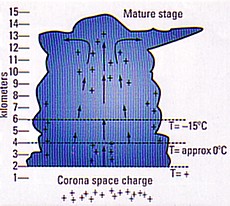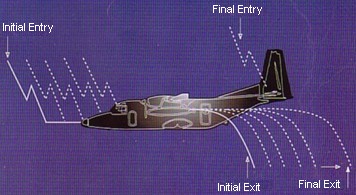
THE AIRLINE PILOTS FORUM & RESOURCE
Lightning Strike |
| by Lighting Technologies -- Source: PIA Flight Safety Publication |
 |
What Pilots Should Know About Lightning
Strike incidence data show that there are more lightning strikes to aircraft below about 20,000 ft than above this altitude, and that jet aircraft are being struck at lower than cruise altitudes, that is during climb, descent or hold operations.
Strikes occurring above around 10,000 ft are associated with positive and negative charge centres in a cloud, or between adjacent clouds. Some lightning strikes below about 10,000 ft probably result from cloud to ground flashes.
So the data seem to indicate that an aircraft must be within or beneath a cloud to be struck.
Incidence data also show that most strikes occur in or near regions of precipitation. The amount of lightning activity is related to how much precipitation there is, and the presence of vertical air currents (turbulence).
Nevertheless strikes have been reported to aircraft flying 25nm from the nearest radar returns or precipitation. There are no confirmed reports of aircraft being struck by lightning when operating in clear air longer distances from clouds.
Avoidance: Commercial and military pilot training and procedures instruct pilots to avoid thunderclouds of regions of precipitation that can be seen or are apparent on radar.
However, the limitation of radar for avoiding lightning associated with clouds is that radar usually only picks up rain, not the cloud itself. So aircraft can experience occasional encounters with hail, and with lightning, without warning.
Fortunately, new generation radars have features that detect wind shears and other forms of precipitation.
Data from the airlines strike reporting projects show that lightning strikes to aircraft in the US and Europe occur most often during the spring and summer months when frontal weather conditions that produce thunderstorms and other regions of convective activity are most prevalent.
There are varying opinions about what detour distance pilots should apply to avoid turbulence and lightning. Most commentators agree that pilots should use distances commensurate with the capability of the radar available. A typical lightning avoidance policy could be:
When the temperature at flight level is 0°C or higher, avoid all echoes showing sharp gradients by at least 5nm.
When the temperature at flight level is less than 0°C, avoid all echoes showing sharp gradients by at least 10nm.
When flying above 23,000 ft avoid all echoes (even if no sharp gradients are indicated) by at least 20nm.
A lightning strike is imminent when a combination of the following conditions is present:
Flight through or near unstable air, a stationary front, a cold front, a warm front or a squallline.
Within a cloud.
Ice types of precipitation.
Air temperature near 0°C
Progressive build-up of radio static.
St Elmo’s fire (when dark).
Turbulence.
At altitudes between 5000 ft and 15,000 ft (most prevalent at around 11,000ft).
Climbing or descending. If you believe a lightning strike is likely, you should:
i) Avoid areas of heavy precipitation.
ii) Change altitude to avoid temperatures near 0°C.
ELECTRICAL CHARGE WITHIN A CUMULONIMBUS CELL

Highly Charged: An initial strike can be up to 200,000 A, equivalent to the current required to run 20,000 single-bar heaters or 800,000 light bulbs (60W).
FLASH DANCE

Lightning usually attaches to or enters an aircraft at one point - often an extremity - and exits from another. That is the current flows into one point of the aircraft and out of another. The entry point might be either an anode or a cathode, that is, a spot where electrons are either entering or exiting the aircraft.
Because most aircraft fly further than their own lengths within the lifetime of most flashes, the location of the entry point changes as the flash re-attaches to other points aft of the initial entry point. The location of the exit points may also change particularly if the initial exit point is at a forward portion of the aircraft.
Therefore for any one flash, there may be many entry or exit points.
